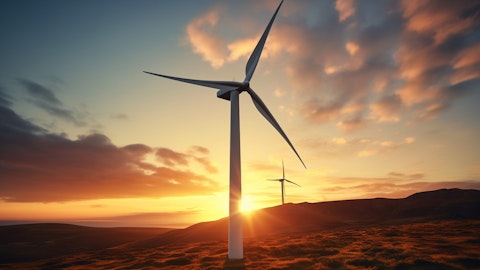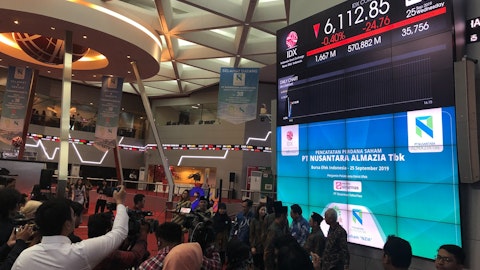Tesla, Inc. (NASDAQ:TSLA) Q3 2023 Earnings Call Transcript October 18, 2023
Tesla, Inc. misses on earnings expectations. Reported EPS is $0.66 EPS, expectations were $0.73.
Elon Musk: [Call Starts Abruptly]…of new factories and we believe there’s still meaningful room for improvement there. Regarding Autopilot and AI, our vehicles are now driven over 0.5 billion miles with FSD beta, full self-driving beta, and that number is growing rapidly. We recently completed a 10,000 GPU cluster of H100s. We think probably bring it into operation faster than anyone’s ever brought that much compute per unit time into production, since training is the fundamental limiting factor on progress with full self-driving and vehicle autonomy. We’re also seeing significant promise with FSD version 12. This is the end-to-end AI where it’s photon count in, controls out. Really you can think of it as there’s just a large bitstream coming in and a tiny bitstream going out, compressing reality into a very small set of outputs, which is actually kind of how humans work.
The vast majority of human data input is optics from our eyes. And so, we are like the car, photons in, controls out with neural nets, just neural nets in the middle. So, interesting to think about that. We’ll continue to invest significantly in AI development, as this is really the mass game changer. And I mean success in this regard in the long-term I think has the potential to make Tesla the most valuable company in the world by far. If you have fully autonomous cars at scale and fully autonomous humanoid robots that are truly useful, it’s not clear what the limit is. Regarding energy storage, we deployed 4 gigawatt hours of energy of storage products in Q3. And as this business grows, the energy division is becoming our highest margin business.

A mix of Tesla electric cars driving on a highway, showing the latest electric transportation technology.
Energy and service now contribute over $0.5 billion to quarterly profit. The Cybertruck, I know a lot of people are excited about the Cybertruck. I am too. I’ve driven the car. It’s an amazing product. I do want to emphasize that there will be enormous challenges in reaching volume production with the Cybertruck, and then in making a Cybertruck cash flow positive. This is simply normal for when you’ve got a product with a lot of new technology or any new vehicle, brand new vehicle program, but especially one that is as different and advanced as the Cybertruck, you will have problems proportionate to how many new things you’re trying to solve at scale. So, I just want to emphasize that while I think this is potentially our best product ever and I think it is our best product ever, it is going to be — require immense work to reach volume production and be cash flow positive at a price that people can afford.
Often people do not understand what is truly hard. That’s why I say prototypes are easy, production is hard. People think it’s the idea, or you make a prototype, you design a car. And as soon as they’re designing a car, it’s just anyone can do it, it does require taste, it does require effort to design a prototype. But it’s difficult to going from a prototype to volume production, it’s like 10,000% harder to get to volume production than to make a prototype in the first place, and then it is even harder than that to reach positive cash flow. That is why there have not been new car startups that have been successful for a 100 years apart from Tesla. So, I just want to temper expectations for Cybertruck. It’s a great product, but financially it will take, I don’t know, a year to 18 months before it is a significant positive cash flow contributor.
I wish there was some way for that to be different, but that’s my best guess. The demand is off the charts. We have over 1 million people who’ve reserved the car. So it’s not a demand issue, but we have to make it and we need to make it at a price that people can afford, insanely difficult things. In conclusion, we continue to focus on ramping production while maintaining positive cash flow and we continue to target — expect to have around 1.8 million vehicle deliveries, as stated earlier this year. The Tesla AI team is I think one of the world’s best, and I think it is actually by far the world’s best when it comes to real world AI. I’ll say that again, Tesla has the best real world AI team on earth, period, and it’s getting better.
See also 15 Best Places to Retire in Australia and 15 Most Powerful Militaries in Africa.
Q&A Session
Follow Tesla Inc. (NASDAQ:TSLA)
Follow Tesla Inc. (NASDAQ:TSLA)
And lastly, I wanted to thank all of our employees who are making a lot of extra effort during uncertain times. Thank you very much for your hard work and the impact that you’re making.
Martin Viecha: Thank you very much, Elon. And our CFO, Vaibhav, has some opening remarks as well.
Vaibhav Taneja: Thanks, Martin. Vehicle deliveries in Q3 outpaced production, and we had yet another record quarter of profitability in our energy business. Congratulations to the Tesla team for the continued focus on operational excellence as we navigate through a period of economic uncertainty, higher interest rates, and shifting consumer sentiment. As Elon mentioned, our Q3 operational and financial performance was impacted by planned downtimes for our factory upgrades. This was necessary to allow for further factory improvements and production rate increases. Despite such factory shutdowns, our cost per vehicle decreased to approximately $37,500. We saw sequential decreases in material cost and freight. Reducing the cost of our vehicles is our top priority.
On the operating expenses front, R&D expenses continued to rise due to Cybertruck prototype builds and pilot production testing combined with spend on AI technologies like full self-driving, Optimus and Dojo. We have and will continue to make investments in these areas, and hence our capital expenditure and R&D will continue to grow in the near term. However, our focus is to continue making investments through positive cash flow from operations. This year itself, we have generated operating cash flows of approximately [$8.9 billion] (ph) and free cash flows of approximately $2.3 billion. Our other businesses are becoming more prominent on a standalone basis with energy business leading the charge, primarily from the growth in Megapack deployments.
Our services and other businesses on a year-on-year basis also continue to show positive momentum as we benefit from our growing fleet. As regards our pricing strategy, in addition to what we have shared before, I want to elaborate that most car buying happens with one or other form of financing, and hence we also view pricing in terms of monthly costs for the customer. And therefore, as interest costs in the U.S. have risen substantially, it has required us to adjust the price of our vehicles to keep the monthly cost in parity. We’ve tried to offset such adjustments via focus on reducing costs. However, there is an inherent lag in cost reductions, which in turn impacts margins. To that extent, we recently announced a partner vehicle leasing program in the U.S. whereby you can get a standard Model Y for as low as $399 a month.
In conclusion, as we navigate through a challenging economic environment, we’re focused on reducing costs, maximizing delivery volumes, and continuing making investments in the future, in particular, AI and other next generation platform. We believe this strategy positions us well for the long term. Once again, I would like to thank the Tesla team for their efforts in the last quarter.
A – Martin Viecha: Thank you very much. And now let’s go to investor questions. The first investor question comes from Craig. How many Cybertruck deliveries do you anticipate for 2024?
Elon Musk: It’s difficult to make an accurate guess at this point. Going back to what I said earlier that the ramp is going to be extremely difficult. And like I said, there’s no way around that. If you try to make — if we just try to do some copycat vehicle design, of which there are literally 200 models that are slight variations on a theme in the combustion engine world, distinctions without a difference, then it’s really not that hard. But if you want to do something radical and innovative and something really special, like the Cybertruck, it is extremely difficult because there’s nothing to copy. You have to invent not just the car, but the way to make the car. So, the more uncharted the territory, the less predictable the outcome.
Now, I can say that — if you say, well, where will things end up? I think we’ll end up with roughly a 0.25 million Cybertrucks a year, I don’t think we’re going to reach that output rate next year. I think we’ll probably reach it sometime in 2025. That’s my best guess.





